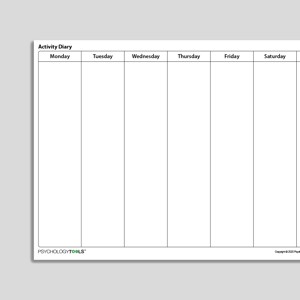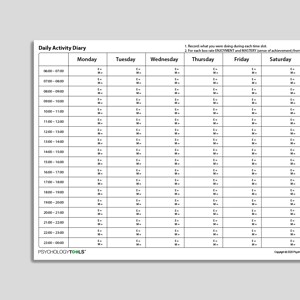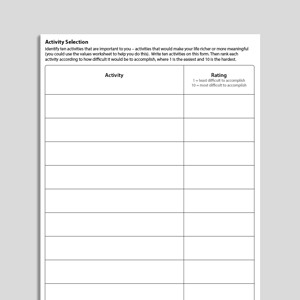Behavioral Activation (BA)
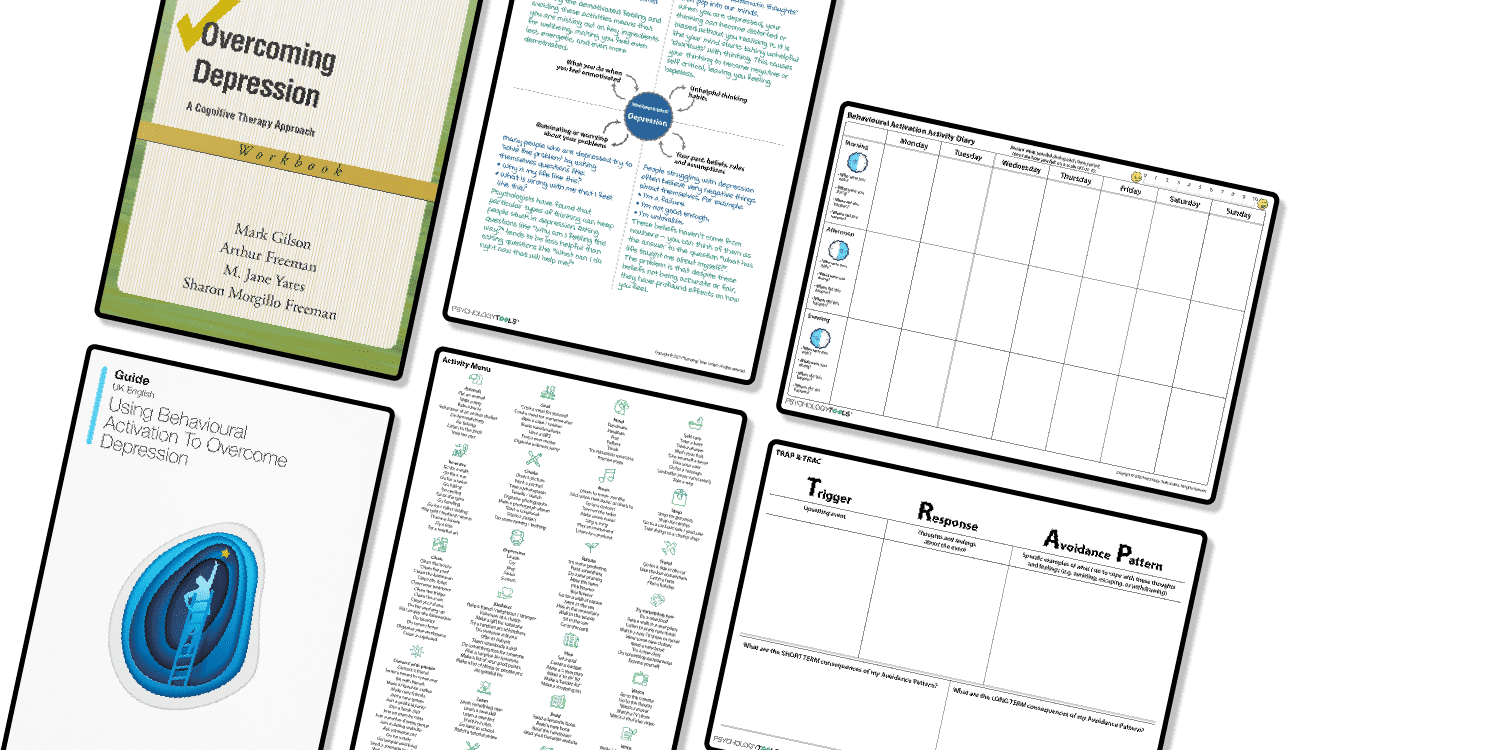
Values
Managing Bipolar Disorder: Therapist Guide
Activity Menu
Using Behavioral Activation To Overcome Depression
Behavioral Activation Activity Diary
Overcoming Depression (Second Edition): Workbook
What Keeps Depression Going?
Behavioral Activation Activity Planning Diary
Managing Bipolar Disorder: Workbook
Values: Connecting To What Matters
Activity Planning
Brief Behavioral Therapy For Anxiety And Depression In Youth: Workbook
Activity Diary (Hourly Time Intervals)
Choosing Your Values
Changing Avoidance (Behavioral Activation)
Overcoming Depression (Second Edition): Therapist Guide
Valued Domains
Exploring Valued Domains
Brief Behavioral Therapy For Anxiety And Depression In Youth: Therapist Guide
[Free Guide] An Introduction To Values
Activity Diary (No Time Intervals)
CBT Daily Activity Diary With Enjoyment And Mastery Ratings
Mastery And Pleasure Activity Diary
Activity Selection
Task Planning And Achievement Record
Things To Do List
Links to external resources
Psychology Tools makes every effort to check external links and review their content. However, we are not responsible for the quality or content of external links and cannot guarantee that these links will work all of the time.
Assessment
- Valued Living Questionnaire (Version 2) | Wilson, Groom | 2002
Guides and workbooks
- Get active feel good (behavioral activation) – CBT workbook from CEDAR | Paul Farrand, Adrian Taylor, Colin Greaves & Claire Pentecost | 2013
Information Handouts
- If you do anything 100 times you will get pretty good at it | TA-TUTOR.com
Presentations
- Behavioral activation: an effective intervention for late life depression | Dolores Gallagher-Thompson, Kim Bullock | 2012
- Behavioral activation for depression and PTSD | Amy Wagner
- Behavioral activation | David Fresco
- Brief behavioural activation (BA) treatment for depression (BATD) | Carl Lejuez | 2014
- Treating depression with behavior therapy: The implementation of behavioral activation | Christopher Martell, Sona Dimidjian, Steven Hollon archive.org
Self-Help Programmes
-
Behavioral Activation For Depression
| Southwark Psychological Therapies Service | 2012
- Introduction to BA for depression
- Monitoring Activity And Mood
- Roadmap: The Activation Plan
- Finding Direction: Values, Flow, And Strengths
- Avoidance And Depression TRAPs
- Thinking Habits
- Next Steps
Treatment Guide
- Behavioural activation treatment for depression (BATD) manual | Lejuez, Hopko & Hopko | 2001
- Behavioural activation treatment for depression – revised (BATD-R) manual | Lejuez, Hopko, Acierno, Daughters, Pagoto | 2011
- Ten Year Revision of the Brief Behavioral Activation Treatment for Depression (BATD): Revised Treatment Manual (BATD-R) | Lejuez, Hopko, Acierno, Daughters, Pagoto | 2011
- A Brief Behavioral Activation Treatment for Depression: Treatment Manual | Lejuez, Hopko, Hopko | 2001
Recommended Reading
- Dimidjian et al (2006). Randomized trial of behavioral activation, cognitive therapy, and antidepressant medication in the acute treatment of adults with major depression. Journal of Consulting and Clinical Psychology, 74(4), 658-670 archive.org
- Behavioural activation treatment for depression: returning to contextual roots | Jacobson, Martell, Dimidjian | 2001
- Veale, D. (2008). Behavioral activation for depression. Advances in Psychiatric Treatment, 14, 29-36
- Jacobson, N. S., Dobson, K. S., Truax, P. A., Addis, M. E., Koerner, K., Gollan, J. K., Gortner, E., Prince, S. E. (1996). A component analysis of cognitive-behavioral treatment for depression. Journal of Consulting and Clinical Psychology, 64(2), 295-305
- Jacobson, N. S., Martell, C. R., & Dimidjian, S. (2001). Behavioral activation treatment for depression: Returning to contextual roots. Clinical Psychology: science and practice, 8(3), 255-270.
- Hopko, D. R., Ryba, M. M., McIndoo, C., & File, A. (2015). 14 Behavioral Activation. The Oxford Handbook of Cognitive and Behavioral Therapies, 229
- Ferster, C. B. (1973). A functional analysis of depression. American Psychologist, 28 (10), 857. | Ferster
- Dobson, K. S., Hollon, S. D., Dimidjian, S., Schmaling, K. B., Kohlenberg, R. J., Gallop, R. J., … & Jacobson, N. S. (2008). Randomized trial of behavioral activation, cognitive therapy, and antidepressant medication in the prevention of relapse and recurrence in major depression. Journal of consulting and clinical psychology, 76(3), 468
What Is Behavioral Activation?
History of BA
BA has its origins in the Skinner’s radical behavioral approach (Skinner, 1953). In the 1970s behaviorists trained by Skinner developed behavioral models of depression that proposed that depression could be treated by re-establishing contact with positive reinforcement and by learning social skills that are helpful for maintaining contact with stable sources of positive reinforcement (Ferster, 1973; Lewinsohn, 1974; Lewinsohn, Antonuccio, Steinmetz-Breckenridge, & Teri, 1984). Aaron Beck recognized the value of behavioral techniques in the treatment of depression and incorporated them into the original cognitive therapy manual (Beck, Rush, Shaw, & Emery, 1979). The paradigm shift toward cognitive approaches meant that purely behavioral treatments received relatively less attention. However, in 1996 Jacobson and colleagues published a component analysis comparing activity scheduling / behavioral activation; cognitive restructuring; and a combination of activity scheduling, cognitive restructuring, and core belief modification. The surprising result was that the combined CBT condition performed no better than the behavioral or cognitive interventions alone. In the wake of the Jacobson component analysis Martell, Addis, and Jacobson published a BA treatment package Depression in Context: Strategies for Guided Actionin 2001. At the same time Lejuez, Hopko, and Hopko published an alternative BA package in 2001 titled Brief Behavioral Activation Treatment for Depression (BATD). Hopko, Lejuez, Ruggiero, and Eifert (2003) published a helpful comparison of the BA and BATD packages, and Kanter, Busch, and Rusch (2009) provide a helpful synthesis of BA and BATD concepts.
BA Interventions
Two different implementations of behavioral activation are widely used: BA and BATD. Intervention techniques in BA/BATD include:
- activity monitoring
- activity scheduling / simple activation
- identifying and overcoming avoidance
- attending to client values to guide activation
- functional analysis to understand the function and reinforcers of behavior
- stimulus control interventions to modify the client’s environment in ways intended to evoke target behavior
- contingency management (shaping rewards and reinforcers)
- skills training (problem solving, skills training, social skills training)
- mindful valued activation (preventing emotional avoidance)
- relapse prevention
References
- Beck, A. T., Rush, A. J., Shaw, B. F., & Emery, G. (1979). Cognitive therapy of depression. New York: Guilford Press.
- Ferster, C. B. (1973). A functional analysis of depression. American Psychologist, 28(10), 857–870.
- Hopko, D. R., Lejuez, C. W., Ruggiero, K. J., & Eifert, G. H. (2003). Contemporary behavioral activation treatments for depression: Procedures, principles, and progress. Clinical Psychology Review, 23(5), 699–717.
- Jacobson, N. S., Dobson, K. S., Truax, P. A., Addis, M. E., Koerner, K., Gollan, J. K., … & Prince, S. E. (1996). A component analysis of cognitive-behavioral treatment for depression. Journal of Consulting and Clinical Psychology, 64(2), 295–304.
- Kanter, J. W., Busch, A. M., & Rusch, L. C. (2009). Behavioral activation. CBT Distinctive Features Series.New York: Routledge.
- Lejuez, C. W., Hopko, D. R., & Hopko, S. D. (2001). A brief behavioral activation treatment for depression: Treatment manual. Behavior Modification, 25(2), 255–286.
- Lewinsohn, P. (1974). A behavioral approach to depression. In R. J. Friedman & M. M. Katz (Eds.), Psychology of depression: Contemporary theory and research. Washington, DC: Winston.
- Lewinsohn, P. M., Antonuccio, D. O., Steinmetz-Breckenridge, J., & Teri, L. (1984). The coping with depression course. Eugene, OR: Castalia Press.
- Martell, C. R., Addis, M. E., & Jacobson, N. S. (2001). Depression in context: Strategies for guided action. New York: Norton.
- Skinner, B. F. (1953). Science and human behavior (No. 92904). Simon and Schuster.










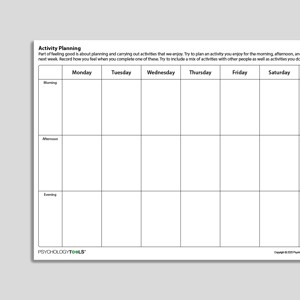








![[Free Guide] An Introduction To Values](https://media-engine-production-public.s3.eu-west-2.amazonaws.com/28518/conversions/%2A-an_introduction_to_values_en-gb_Guides_Cover-preview.jpg)
